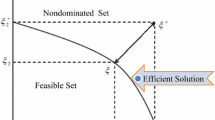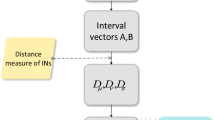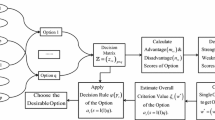Abstract
Interval-Valued Intuitionistic Fuzzy Set (IVIFS) is an effective tool to model uncertainty, and has received much attention. When applying IVIFS to solve real problems such as Multi-Attribute Decision Making (MADM) problem, how to measure the distance between two Interval-Valued Intuitionistic Fuzzy Values (IVIFVs) is an essential problem. In this paper, a novel distance of IVIFS called Interval-Valued Intuitionistic Fuzzy Jenson-Shannon (IVIFJS) divergence is proposed, which can measure the difference or dissimilarity between IVIFSs. First, we propose a new Evaluation Score Function of the IVIFV, the score function considering the weight of membership and non-membership, which is more flexible than other existing score functions of IVIFV. Then, we find that the Evaluation Score Function is enclosed in a fixed interval, denoted as the largest possible range. Additionally, we find that the Evaluation Score Function can be approximately regarded to have Gaussian distribution over its largest range. Based on this, we propose a novel divergence measure operator for IVIFS named Interval-valued Intuitionistic Fuzzy Jenson-Shannon (IVIFJS) divergence by extending from discrete Jenson-Shannon (JS) divergence. Some useful mathematical properties of JS divergence, including boundness, symmetric and triangular inequality, are maintained in the proposed IVIFJS divergence. Next, we design a novel MADM method based on the proposed divergence operator. Further, some numerical examples are evaluated to illustrate the applicability and plausibility of the proposed method by comparing with other existing MADM methods. Then, the robustness and stability of the proposed MADM method are verified through sensitivity analysis on numerical examples. Finally, the proposed MADM method is applied in the applications of medical diagnosis and network system selection to verify the practicability of the proposed method.






Similar content being viewed by others
References
Meng D, Liu M, Yang S, Zhang H, Ding R (2018) A fluid–structure analysis approach and its application in the uncertainty-based multidisciplinary design and optimization for blades. Adv Mech Eng 10(6):1687814018783410
Liu P, Zhang X, Pedrycz W (2020) A consensus model for hesitant fuzzy linguistic group decision-making in the framework of Dempster–Shafer evidence theory. Knowl-Based Syst 212:106559
Xu X, Zheng J, Yang J-, Xu D-, Chen Y- (2017) Data classification using evidence reasoning rule. Knowl-Based Syst 116:144–151
Xiao F (2021) CED: A distance for complex mass functions. IEEE Trans Neural Netw Learn Syst 32(4):1525–1535
Xiao F (2019) Generalization of Dempster–Shafer theory: A complex mass function. Appl Intell 50(10):3266–3275
Xiao F (2020) Generalized belief function in complex evidence theory. J Intell Fuzzy Syst 38 (4):3665–3673
Ye J, Zhan J, Xu Z (2021) A novel multi-attribute decision-making method based on fuzzy rough sets. Comput Ind Eng 155:107136
Fujita H, Gaeta A, Loia V, Orciuoli F (2019) Improving awareness in early stages of security analysis: A zone partition method based on GrC. Appl Intell 49(3):1063–1077
Xiao F (2020) On the maximum entropy negation of a complex-valued distribution. IEEE Trans Fuzzy Syst 29(11):3259– 3269
Babajanyan SG, Allahverdyan AE, Cheong K H (2020) Energy and entropy: Path from game theory to statistical mechanics. Phys Rev Res 2(4):043055
Xue Y, Deng Y (2021) Tsallis extropy. Communications in Statistics-Theory and Methods. https://doi.org/10.1080/03610926.2021.1921804
Liu Z-G, Huang L-Q, Zhou K, Denoeux T (2020) Combination of transferable classification with multisource domain adaptation based on evidential reasoning. IEEE Trans Neural Netw Learn Syst 32 (5):2015–2029
Fu C, Hou B, Chang W, Feng N, Yang S (2020) Comparison of evidential reasoning algorithm with linear combination in decision making. Int J Fuzzy Syst 22(2):686–711
Deng X, Jiang W (2019) A total uncertainty measure for D numbers based on belief intervals. Int J Intell Syst 34(12):3302–3316
Jiang W, Cao Y, Deng X (2019) A Novel Z-network Model Based on Bayesian Network and Z-number. IEEE Trans Fuzzy Syst. https://doi.org/10.1109/TFUZZ.2019.2918999
Tian Y, Liu L, Mi X, Kang B (2020) ZSLF: A new soft likelihood function based on Z-numbers and its application in expert decision system. IEEE Trans Fuzzy Syst. https://doi.org/10.1109/TFUZZ.2020.2997328
Liu Q, Tian Y, Kang B (2019) Derive knowledge of Z-number from the perspective of Dempster–Shafer evidence theory. Eng Appl Artif Intell 85:754–764
Zhou M, Liu X-B, Chen Y-W, Qian X-F, Yang J-B, Wu J (2020) Assignment of attribute weights with belief distributions for MADM under uncertainties. Knowl-Based Syst 189:105110
Xiao F (2021) CaFtR: A fuzzy complex event processing method. Int. J. Fuzzy Syst. https://doi.org/10.1007/s40815-021-01118-6
Xiao F (2020) Evidence combination based on prospect theory for multi-sensor data fusion. ISA Trans 106:253–261
Cao Z, Lin C-T (2018) Inherent fuzzy entropy for the improvement of EEG complexity evaluation. IEEE Trans Fuzzy Syst 26(2):1032–1035
Li Y-X, Pelusi D, Deng Y (2020) Generate two dimensional belief function based on an improved similarity measure of trapezoidal fuzzy numbers. Comput Appl Math. https://doi.org/10.1007/s40314-020-01371-9
Fujita H, Cimr D (2019) Decision support system for arrhythmia prediction using convolutional neural network structure without preprocessing. Appl Intell. https://doi.org/10.1007/s10489-019-01461-0
Xiao F (2021) A distance measure for intuitionistic fuzzy sets and its application to pattern classification problems. IEEE Trans Syst Man Cybern Syst 51(6):3980–3992
Liu Z-G, Liu Y, Dezert J, Cuzzolin F (2019) Evidence combination based on credal belief redistribution for pattern classification. IEEE Trans Fuzzy Syst 28(4):618–631
Xiao F (2021) GIQ: A generalized intelligent quality-based approach for fusing multi-source information. IEEE Trans Fuzzy Syst 29(7):2018–2031
Atanassov K (1986) Intuitionistic fuzzy sets. Fuzzy Sets Syst 31:343–349
Atanassov K, Gargov G (1989) Interval valued intuitionistic fuzzy sets. Fuzzy Sets Syst 31 (3):343–349
Fei L (2019) On interval-valued fuzzy decision-making using soft likelihood functions. Int J Intell Syst. https://doi.org/10.1002/int.22110
Jiang W, Huang K, Geng J, Deng X (2020) Multi-scale metric learning for few-shot learning. IEEE Trans Circ Syst Video Technol. https://doi.org/10.1109/TCSVT.2020.2995754
Liao H, Ren Z, Fang R (2020) A Deng-entropy-based evidential reasoning approach for multi-expert multi-criterion decision-making with uncertainty. Int J Comput Intell Syst 13(1):1281–1294
Wan S, Dong J (2020) Decision making theories and methods based on interval-valued intuitionistic fuzzy sets. Springer Nature
Wan S, Xu G, Dong J (2020) An atanassov intuitionistic fuzzy programming method for group decision making with interval-valued atanassov intuitionistic fuzzy preference relations. Appl Soft Comput 95:106556
Wan S, Dong J (2020) Additive consistent interval-valued atanassov intuitionistic fuzzy preference relation and likelihood comparison algorithm based group decision making. In: Decision Making Theories and Methods Based on Interval-Valued Intuitionistic Fuzzy Sets. Springer, pp 215–242
Xu Z, Yager R R (2008) Dynamic intuitionistic fuzzy multi-attribute decision making. Int J Approx Reason 48(1):246–262
Garg H, Arora R (2018) A nonlinear-programming methodology for multi-attribute decision-making problem with interval-valued intuitionistic fuzzy soft sets information. Appl Intell 48(8):2031–2046
Chen S-M, Han W-H (2018) An improved MADM method using interval-valued intuitionistic fuzzy values. Inf Sci 467:489–505
Chen S-M, Fan K-Y (2019) Multiattribute decision making based on probability density functions and the variances and standard deviations of largest ranges of evaluating interval-valued intuitionistic fuzzy values. Inf Sci 490:329–343
Wan S, Dong J (2020) A three-phase method for group decision making with interval-valued intuitionistic fuzzy preference relations. In: Decision Making Theories and Methods Based on Interval-Valued Intuitionistic Fuzzy Sets. Springer, pp 243– 270
Wan S, Dong J (2020) A group decision-making method considering both the group consensus and multiplicative consistency of interval-valued intuitionistic fuzzy preference relations. In: Decision Making Theories and Methods Based on Interval-Valued Intuitionistic Fuzzy Sets. Springer, pp 271–313
Deng Y (2020) Information volume of mass function. Int J Comput Commun Control 15(6):3983
Garg H, Rani D (2019) Some results on information measures for complex intuitionistic fuzzy sets. Int J Intell Syst 34(10):2319–2363
Deng Y (2020) Uncertainty measure in evidence theory. Sci China Inf Sci 63(11):210201
Deng J, Deng Y (2021) Information volume of fuzzy membership function. Int J Comput Commun Control 16(1):4106. https://doi.org/10.15837/ijccc.2021.1.4106
Xiao F (2020) CEQD: A complex mass function to predict interference effects. IEEE Trans Cybern. https://doi.org/10.1109/TCYB.2020.3040770
Zhang H, Deng Y (2021) Entropy Measure for Orderable Sets. Inf Sci 561:141–151
Feng F, Cho J, Pedrycz W, Fujita H, Herawan T (2016) Soft set based association rule mining. Knowl-Based Syst 111:268–282
Feng F, Xu Z, Fujita H, Liang M (2020) Enhancing PROMETHEE method with intuitionistic fuzzy soft sets. Int J Intell Syst 35:1071–1104
Xue Y, Deng Y (2020) On the conjunction of possibility measures under intuitionistic evidence sets. J Ambient Intell Human Comput. https://doi.org/10.1007/s12652-020-02508-8
Ma J, Ma Y, Li C (2019) Infrared and visible image fusion methods and applications: a survey. Inf Fusion 45:153–178
Fujita H, Ko Y-C (2020) A heuristic representation learning based on evidential memberships: Case study of UCI-SPECTF. Int J Approx Reason 120. https://doi.org/10.1016/j.ijar.2020.02.002
Fujita H, Gaeta A, Loia V, Orciuoli F (2019) Hypotheses analysis and assessment in counter-terrorism activities: a method based on OWA and fuzzy probabilistic rough sets. IEEE Trans Fuzzy Syst 28:831–845
Mi J, Li Y-F, Peng W, Huang H-Z (2018) Reliability analysis of complex multi-state system with common cause failure based on evidential networks. Reliab Eng Syst Safety 174:71–81
Xue Y, Deng Y (2021) Decision making under measure-based granular uncertainty with intuitionistic fuzzy sets. Appl Intell. https://doi.org/10.1007/s10489-021-02216-6
Pan Y, Zhang L, Li Z, Ding L (2019) Improved fuzzy bayesian network-based risk analysis with s-valued fuzzy sets and D-S evidence theory. IEEE Trans Fuzzy Syst. https://doi.org/10.1109/TFUZZ.2019.2929024
Zhou J, Su X, Qian H (2020) Risk assessment on offshore photovoltaic power generation projects in China using D numbers and ANP. IEEE Access 8:144704–144717
Fei L, Feng Y, Liu L, Mao W (2019) On intuitionistic fuzzy decision-making using soft likelihood functions. Int J Intell Syst 34(9):2225–2242
Xu Z (2007) Methods for aggregating interval-valued intuitionistic fuzzy information and their application to decision making. Control Decis 22(2):215–219
Wang Z, Li K W, Wang W (2009) An approach to multiattribute decision making with interval-valued intuitionistic fuzzy assessments and incomplete weights. Inf Sci 179(17):3026– 3040
Song Y, Fu Q, Wang Y-F, Wang X (2019) Divergence-based cross entropy and uncertainty measures of atanassov’s intuitionistic fuzzy sets with their application in decision making. Appl Soft Comput 84. https://doi.org/10.1016/j.asoc.2019.105703
Lamberti P W, Majtey A P, Borras A, Casas M, Plastino A (2008) Metric character of the quantum Jensen-Shannon divergence. Phys Rev A 77:052311
Newbold P, Carlson W L, Thorne B (2013) Statistics for business and economics. Pearson, Boston
Chen S-M, Chiou C-H (2014) Multiattribute decision making based on interval-valued intuitionistic fuzzy sets, pso techniques, and evidential reasoning methodology. IEEE Trans Fuzzy Syst 23(6):1905–1916
Endres D M, Schindelin J E (2003) A new metric for probability distributions. IEEE Trans Inf Theory 49(7):1858–1860
Tang M, Liao H, Herrera-Viedma E, Chen CLP, Pedrycz W (2020) A dynamic adaptive subgroup-to-subgroup compatibility-based conflict detection and resolution model for multicriteria large-scale group decision making. IEEE Trans Cybern
Wan S, Wang F, Dong J (2019) Theory and method of intuitionistic fuzzy preference relation group decision making. Science Press, Beijing
Acknowledgment
The authors would like to express the sincere appreciation to the editor and anonymous reviewers for their insightful comments, which greatly improve the quality of this paper, and also greatly appreciate research assistant Yangyang Zhao who discussed many issues of this work and support this work. This research is supported by the National Natural Science Foundation of China under Grants 62003280 and 61976120, Chongqing Talents: Exceptional Young Talents Project (CQYC202105031), and the Natural Science Foundation of Jiangsu Province under Grant BK20191445, and the Qing Lan Project of Jiangsu Province.
Author information
Authors and Affiliations
Corresponding author
Additional information
Publisher’s note
Springer Nature remains neutral with regard to jurisdictional claims in published maps and institutional affiliations.
Rights and permissions
About this article
Cite this article
Wang, Z., Xiao, F. & Ding, W. Interval-valued intuitionistic fuzzy jenson-shannon divergence and its application in multi-attribute decision making. Appl Intell 52, 16168–16184 (2022). https://doi.org/10.1007/s10489-022-03347-0
Accepted:
Published:
Issue Date:
DOI: https://doi.org/10.1007/s10489-022-03347-0




